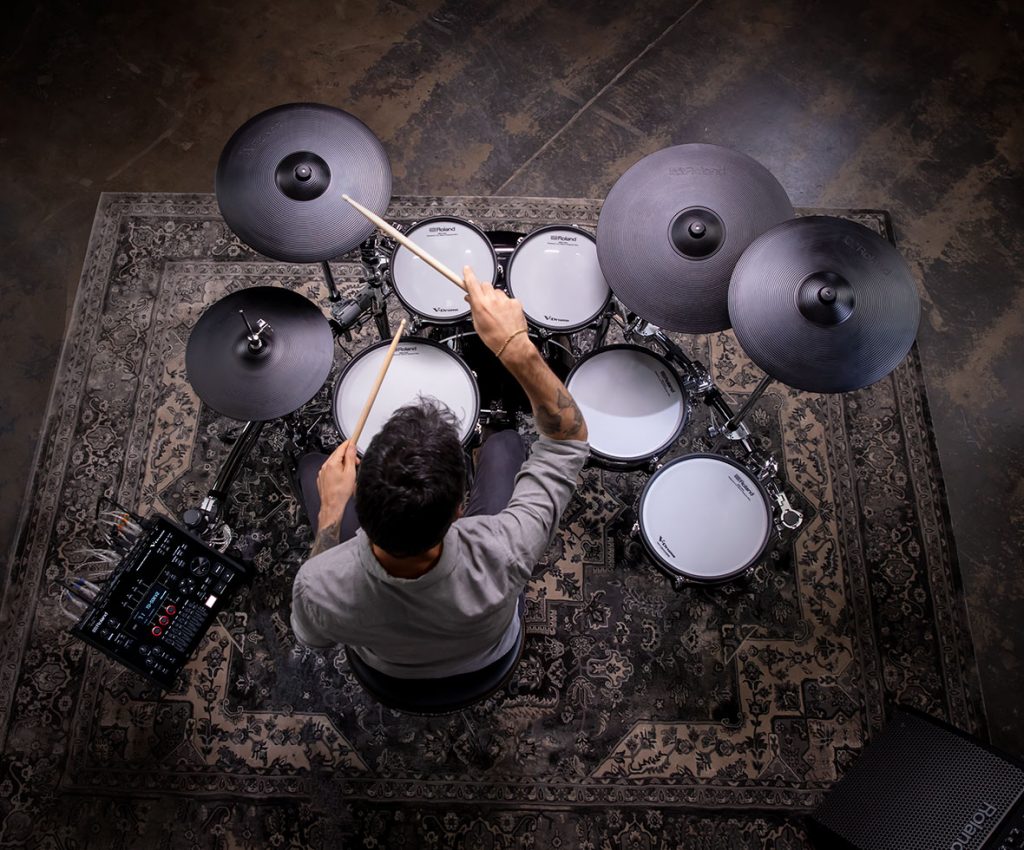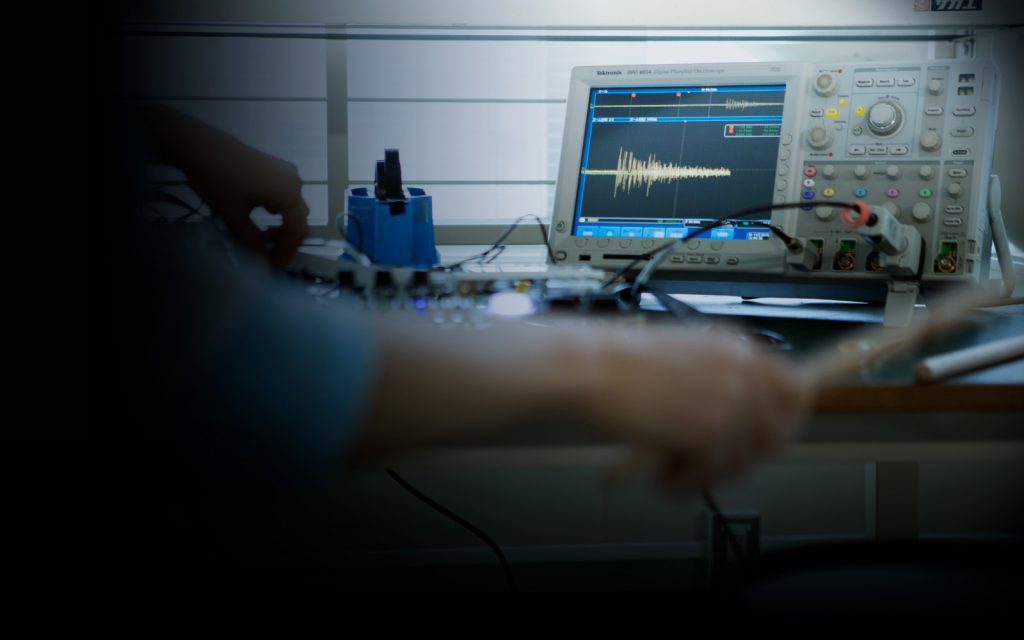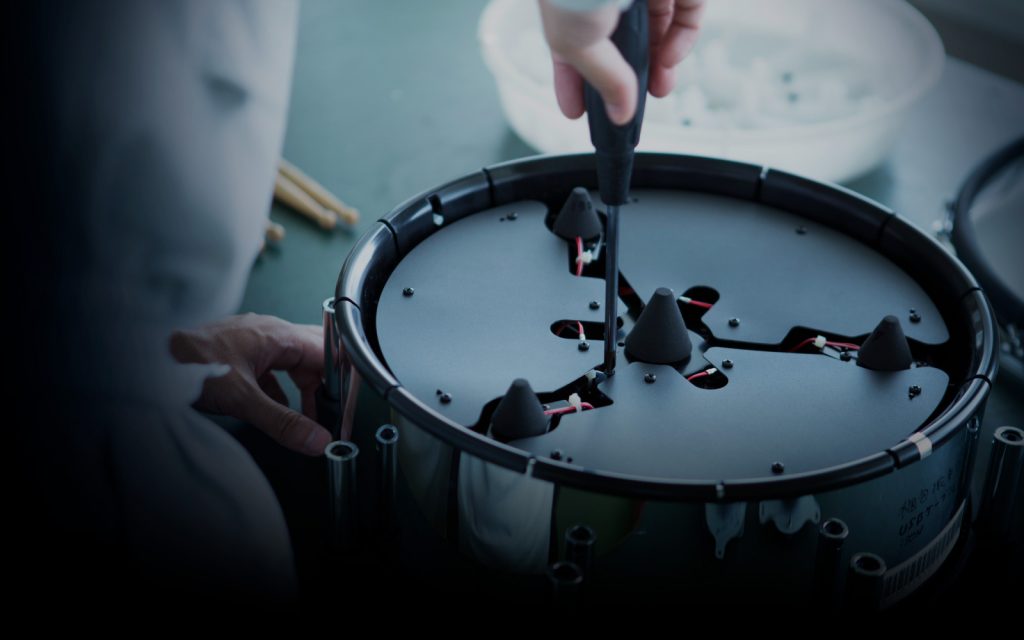Since the TD-10 debuted in 1997, the Roland V-Drums line has continued to evolve and expand, always considering the specific needs of players. Behind the pads are passionate engineers working alongside drummers to constantly improve V-Drums. With Prismatic Sound Modeling, V-Drums have reached unprecedented levels of realism and detail. Engineers Shun Takai and Ryo Takasaki took the time to talk about the innovative modeling engine. They also discuss drum sampling sessions and sensor development, plus reveal some rare historical tidbits about V-Drums.
Prismatic Sound Modeling
Prismatic Sound Modeling is described as influencing how sound behaves, and how original samples and behavior modeling influence each other. Is there an infinite number of combinations?
Shun Takai: Correct. It’s hard to say if it’s an infinite number of combinations, however, because the sound changes are pretty smooth. Thanks to the Prismatic model, even if it’s not entirely infinite, there are probably more than you could count easily because there are so many possibilities.
How is Prismatic Sound Modeling different than traditional “Round-robin” hit randomization/sample playback used by some electronic drum modules?
ST: This is a big question. My opinion of Round-robin is that it’s a simple sample waveform rotation. I think it’s four types of different sounds and hits repeated in the rotation. In the case of Prismatic Sound Modeling, we separate each element. For example, we isolate the snare drum, body, wire, and overtone. The sound module mixes these sounds differently in each situation. For realistic articulation, you don’t want just sample repeats.

"In the case of Prismatic Modeling, we separate each element. We isolate the snare drum, body, wire, and overtone."
The Human Element
What human elements did you consider the most when developing the Prismatic Sound Modeling approach?
ST: This is a good question. I’ll just say we focus on playability and realistic articulation of every hit in terms of strength and feeling.
The prism is a great analogy for the many “colors” of a drum sound. Are you ever been surprised during the engineering process?
ST: I’ve never been surprised exactly, but let me give you an example. Have you tried the TD-50X snare drum? I thought it would be a good idea for the Edit function to affect the snare drum’s wire attack. We tried this for each wire type, and the way it influenced the snare’s sound characteristics was a total change.
"We focus on playability and realistic articulation of every hit in terms of strength and feeling."
How does collaborating with drummers assist development?
ST: The collaboration with drummers is important to technology development. Craig Blundell, Michael Schack, and our other drummers have a lot of experience with both acoustic and electronic drums. Their expression and articulation requests can be difficult. We’d never be able to achieve what they want without using Prismatic Modeling technology.
TD-50X Update
What are some of the most recent changes that make the TD-50X different from its predecessors?
ST: The most important point was to touch up Prismatic Modeling in terms of sound quality and expression. Sometimes updates just add functions or sound content. However, in the case of the TD-50X module, it’s a complete refresh. It sounds totally different from the original TD-50. We prepared a gigantic library for the TD-50X and picked the best 900 instruments.
Creating Atmosphere
PureAcoustic Ambience technology is now built into the TD-50’s Ambience slider. How did this technology initially develop and how does it improve the drummer’s experience?
In short, PureAcoustic Ambience is a simulation of overhead microphones. During a recording session, overheads create ambient sound. For example, the atmosphere around a bass drum sound can be so nice.
In the case of the TD-50X, we focus on what we call the drummer’s position. The sound from where the drummer is listening is important for V-Drums. Kit creator using the PureAcoustic Ambience creates a very atmospheric drum sound.
"We focus on what we call the drummer’s position. The sound from where the drummer is listening is important for V-Drums."

V-Drums History
Since 1997, when Roland launched V-Drums, there have been so many developments. Have COSM and older Roland technologies evolved into Prismatic Sound Modeling?
ST: Engineering is kind of a stairway. Prismatic Sound Modeling combines many Roland technologies. When you think of it in this way, the TD-50X does include older techniques.
How much of Roland’s DSP effects and modeling technology are unique to the drum line? Are there drum effects in AIRA and other products?
ST: V-Drums MFX and System FX are almost the same as our synthesizer products. But in kit creation, we have some very unique V-Drums DSP functions which include our transient shaper and dynamic enhancer.
"Engineering is kind of a stairway. Prismatic Sound Modeling combines many Roland technologies."

Sampling
V-Drums sampling is carried out by the Basic Technology Department. Tell us about the recording process.
ST: First, we need to explain a bit about why we sample. Prismatic Modeling does not use sampled waveforms. The reason we do sampling is for analysis. It’s a strong team effort. Achieving something special requires a lot of sitting in a recording studio and communicating with the drummer. We just focus on getting every articulation recorded. In the case of the different dynamics from soft to hard strength, there can be over fifty separate hits.

"It’s a strong team effort. Achieving something special requires a lot of sitting in a recording studio and communicating with the drummer."
Cymbal Sounds
What are some of the unique challenges of capturing cymbals, in terms of decay, ambience, etc.?
ST: During cymbal sampling, we use condenser microphones. In fact, for cymbals, we were able to try some new types. We focus on the stereo width, because, as I said, we are very concerned with the drummer’s position. As far as decay and ambience, some of our cymbal samples have decays that last up to 30 seconds.

Sensor Development
Was the cross stick sensor a request from drummers?
Ryo Takasaki: The digital PD-140 development began in 2014. We received feedback from professional drummers about cross stick. They want to play more naturally. With previous V-Drums, if you wanted to play cross stick, you had to push the button on the sound module. The playability wasn’t good.
We started to investigate and research solutions. Latency is one of the most important things for playability, and it was difficult to find a sensor with low latency. Eventually, we found the best sensor for cross stick.
Mesh Magic
Can you tell us about the development of the mesh head?
RT: Oh man, that was before my time. I joined Roland in 2009. My boss told me a really interesting story involving a trampoline. After seeing one, he came up with the idea that if we adopted a structure that was more like a trampoline, we could get a more natural feel for our heads.
"If we adopted a structure that was more like a trampoline, we could get a more natural feel for our heads."
In thee three-ply mesh head, the additional floating layer adds greater stick resistance to avoid the bounce effect.
RT: You understand it correctly. The middle layer is a floating structure.
How do you measure how far the mesh head depresses when played at different velocities?
RT: We measure how far you have to deploy using a laser displacement meter. In the case of a 3-layer mesh head like the PD-140DS, we repeat the trial over and over. Then we compare and contrast.
Hi-hats and Kick Drum
The way V-Drums hi-hats react is so natural. Do the upper and lower hats have unique properties?
RT: Overall, we analyze performance information with multiple sensors. The VH-14D digital hi-hat uses multiple sensors to analyze the drummer’s performance. Basically, the top cymbal detects playing information about the shifting position, velocity hitting position, hand touch, etc. The bottom hi-hat has an open-close sensor to detect foot pedal playing. So, they are different.

"The VH-14D digital hi-hat uses multiple sensors to analyze the drummer's performance."
Can you explain the concept of air-damping and share some of the benefits of the KD-A22?
RT: Air damping is an innovation of the KDA-22. Before the KD-A22 was released, we used a kind of cushion to emulate a true bass drum attack. The feeling wasn’t bad, but we wanted to improve it more. So, we investigated acoustic bass drums and found the best solution was air damping. It provides a nice natural feel that benefits players.






